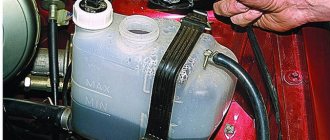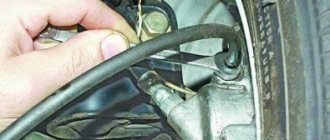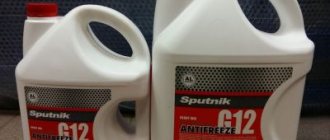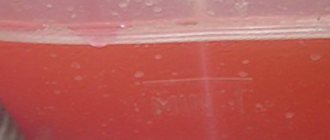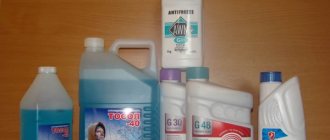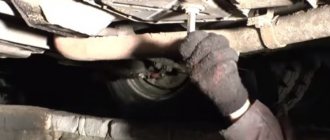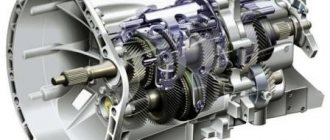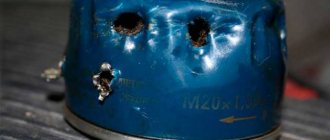Replacing the coolant on a 16-valve VAZ-2112 is quite easy and simple. This does not require special knowledge. It is worth noting that the choice of coolant must be taken seriously, since using a liquid that has exhausted its service life can not only damage the power unit, but also lead to a major overhaul of the engine.
Video about completely replacing the coolant on a VAZ-2112:
Video materials will tell you about the process of replacing the coolant, the stages, and give tips and recommendations.
Antifreeze in a VAZ 2110: how many liters are needed and how to change it
Antifreeze is a special liquid designed to cool a car engine. It is poured into the expansion tank of the system, located under the hood of the car. The fluid requires periodic replacement, since after a certain period of engine operation it loses its original properties. Therefore, young car enthusiasts are interested in how much antifreeze is in the VAZ 2110 cooling system.
After a certain mileage and operation of the VAZ 2110 car, it is necessary to carry out a technical inspection, monitor the level of oil and coolant in the system. After a certain period of operation, all lubricants and coolants lose their original technical and operational characteristics and require replacement. Therefore, before replacing the coolant, you need to find out how much antifreeze is in the cooling system of the VAZ 2110.
Many inexperienced car enthusiasts, when replacing antifreeze or antifreeze in a car's cooling system, fill in 5-6 liters of fluid and make sure that it has reached the maximum level in the expansion tank, consider this sufficient and close the hood of the car. This is their big mistake, since the antifreeze has not yet had time to completely fill the system. You need to wait about five minutes until the liquid level in the tank drops significantly. Accordingly, you will need to add more coolant.
This procedure must be done several times, only then will it be clear how many liters of antifreeze are in the VAZ 2110 cooling system. It is necessary to add fluid until its level stops at one mark, which should be above the minimum and below the maximum level. Not adding enough antifreeze or antifreeze can cause the engine to overheat and fail. It is also impossible to overfill coolant, since when heated it tends to increase in volume.
After pouring antifreeze (antifreeze), you need to perform the following steps:
- close the expansion tank cap;
- start the engine and wait until it warms up before turning on the fan;
- turn off the engine and let it cool down;
- Check the coolant level in the tank and top up if necessary.
How to fix problems
Now let's talk about eliminating these faults according to the list presented.
- Coolant cannot disappear with the wave of a magic wand; it does not evaporate under the influence of temperature. Therefore, you need to check all pipes, hoses, clamps, radiator and other components. There is bound to be damage somewhere causing a leak.
- If in winter you have to stand still for a long time waiting for the engine to warm up, try insulating the engine compartment. There are many ways to do this - from the classic “sheep coat” for the engine, to using simple cardboard in front of the radiator in winter, or using special insulation. Be sure to ensure that your insulation does not touch the generator belt.
- In the event of detonation, we can only sympathize with the car, since its owner completely ignored all the signals from the car that the CO was in a faulty state. If the simplest repair measures give a positive result, consider yourself very lucky. If not, then engine repair cannot be avoided. And these are completely different amounts of money.
- When the sensor needle is in the red zone, immediately take appropriate measures. Turn off the engine to prevent excessive overheating from leading to even worse consequences. Raise the hood and check for fluid in the reservoir. Just don't open it, it's very hot in there. With a timely reaction, you can avoid boiling and whistling from under the hood. But it’s better not to drive to the service station on your own. Call a tow truck.
- Situations where engine head gaskets break are not uncommon. But we don’t want anyone to encounter them. Such a breakdown indicates that you must begin a full engine repair. On your own or at a car service - decide for yourself.
Instructions for replacing coolant
Most owners of domestically produced cars prefer to carry out repairs and maintenance of their own cars themselves. Therefore, inexperienced car enthusiasts are interested in how to change antifreeze on a VAZ 2110. First, you need to drain the used fluid.
Draining used antifreeze:
- First you need to install the vehicle in a place convenient for performing work. In this case, the car must be level, or you can raise its front part, but not the rear.
- The terminal is removed from the battery so that if liquid accidentally gets on the exposed wire, a short circuit does not occur.
- If the car uses an injector, the ignition module is removed, otherwise it will interfere with unscrewing the drain plug from the cylinder block.
- To quickly drain the antifreeze from the system, the cap from the expansion tank is also unscrewed.
- Now you need to completely unscrew the plug on the engine cylinder block using a spanner (spanner).
- When the liquid has completely drained from the block, it is advisable to wipe the engine with a rag, precisely those areas where the used antifreeze came into contact during the draining process. There is no need to screw the plug back yet.
- Now the radiator cap is unscrewed and the liquid is drained into a separate container.
Replacing antifreeze
To work we will need:
- Wide container with a volume of at least 8 liters;
- Key to 13;
- Inspection hole or overpass
- Removing the engine splash guard
- Unscrew and remove the plug from the expansion tank
- Place a prepared container under the radiator drain hole
- Unscrew the drain plug on the radiator and drain the coolant
- Next you need to place a container under the hole on the cylinder block
- We unscrew the drain plug on the block using a 13mm wrench and drain the remaining coolant.
Coolant filling procedure
It’s worth checking first how much antifreeze is needed in a VAZ 2110 for 16 antifreeze valves. After this, you can begin work.
- The coolant drain hose is removed from the throttle valve. To do this, you first need to loosen the clamp holding it. The hose should not be thrown on the ground; it must be suspended from something nearby.
- The liquid must be poured slowly and observed whether it flows from any hose. If there is a leak, quickly put the hose back in place. After this, add antifreeze to the required level and close the plug.
Necessary tools and materials for oil change
To change the oil you will need the following tools:
- wrenches “10”, “17” and “24”;
- oil filter remover;
- wheel wrench;
- containers for used oil;
- gloves;
- bedding on the ground;
- rags;
- new filter and oil.
Suitable components: Semi-synthetic motor oil “Lukoil Lux 10W-40”, (5 l) article number - 19299. Price about 1100 rubles. Original oil filter for the Lada engine 21080101200508. Price 180 rubles. Analogues: BM FO2108 – 140 rubles, JS Asakashi C0065 – 150 rubles.
Prices are current for the summer of 2017 for Moscow and the region.
1 Warm up the engine, warm oil will drain faster. We put the car on a jack and remove the right front wheel.
2 Find the drain plug and place a container under it to drain the waste. Unscrew and drain. At the end of the process, install the plug back.
4Remove the filler plug.
5You need to prepare a new filter, pour oil into it and lubricate the rubber gasket on top.
6Unscrew the old filter and install a new one in its place.
8Reinstall the filler plug.
9Start the engine and let it idle for 5-10 minutes. The oil should be distributed throughout the system, and the oil indicator (in the form of an oil can) should go out.
10Check the level. If necessary, add more oil. We changed everything, oil and filter.
All car owners, without exception, are well aware that the trouble-free operation of their car directly depends on the correctness and regularity of the relevant service work. That is why it is necessary to carry out such maintenance on a regular basis. Changing the oil of a VAZ 2112 in an engine with 16 valves will extend the service life of the engine and save the car owner from the need for complex, expensive repairs of the power unit.
Optimal coolant option
When you have figured out how to replace antifreeze on a VAZ 2110 (2112), it is important to choose the optimal fluid option. Many car enthusiasts only use expensive antifreeze, considering it to be of higher quality.
For VAZ cars, it is quite possible to use a cheap domestic product - antifreeze, the characteristics of which were developed specifically for these cars.
Owners of domestic cars respond positively to Felix brand antifreeze. It is sold in canisters of 5 and 10 liters, and smaller containers. It is profitable to purchase liquid in a 10 kg container - it is cheaper, and after replacing the used antifreeze, there is still liquid left for refilling.
Didn't find the information you are looking for? on our forum.
How much antifreeze is in the VAZ 2110 system
is a special liquid that is poured into the car’s expansion tank for cooling. It needs to be changed from time to time. After all, after traveling several tens of kilometers, antifreeze loses its properties. Knowing how much antifreeze is in the VAZ 2110, you can correctly replace the coolant and extend the life of your car.
Everyone knows that the engine temperature changes during operation. Antifreeze should maintain it at an optimal level. This is his main task, although not the only one.
A little about volumes
The cooling system in the VAZ 2110 is almost the largest in the structure of the car. The volume of coolant in the VAZ 2110 is second only to the volume of the fuel tank.
How much antifreeze should circulate
It is believed that the VAZ 2110 cooling system should contain 7.8 liters of antifreeze. This is exactly the amount of it that will ensure the uninterrupted operation of all systems at any time of the year.
It is this substance that protects the engine from overheating in the summer.
, which is fraught with boiling of the engine. If this happens, then you will have to spend a lot on major repairs. Although it is not a fact that in this case he will save the situation. At negative outside temperatures, antifreeze will protect the “heart” of your “iron horse” from freezing and all year round it will help protect the main elements of the car from corrosion.
How much antifreeze should be poured
The VAZ 2110 is filled with coolant as soon as the existing antifreeze begins to lose its properties. You can tell this by the color change.
When you change the fluid, do not think that five or six liters will be enough, since the antifreeze level has reached its maximum level in the expansion tank. But that's not true.
It is necessary to wait until all the antifreeze is distributed throughout the system. This may take a few minutes.
When adding coolant, make sure that it is not higher than the maximum and not lower than the minimum level. If there is not enough antifreeze, the engine will overheat. Also remember that when heated, liquid expands and therefore increases in volume. So it’s also not worth pouring antifreeze above the MAX mark.
Answers (2)
The coolant filling volume in models 2110, 2112 is 7.8 liters. However, in practice, you will not always be able to drain exactly this volume, therefore, fill in the same amount as you drained, to the required level.
As for the choice of antifreeze or antifreeze, I will say that antifreeze is better than antifreeze. If only because when using antifreeze, the pump lasts longer than when using antifreeze. And the price difference is not much more expensive.
Owners most often fill in green antifreeze, for example Sintek Euro G11 or FELIX Prolonger -40 G11, or other manufacturers, of which there are a lot now on the market and, in particular, even at gas stations.
As for antifreeze, choose it regardless of color.
According to the replacement interval, according to the maintenance schedule it is 150,000 km. However, in practice this interval can be reduced to 100 thousand km.
coolant expansion tank VAZ 2110, 2112
Is it possible to mix
Despite the fact that classes G11, G12, G12+ contain ethylene glycol, different manufacturers use different types of additives. Therefore, I still would not recommend mixing even G12 and G12+. And even more so, you cannot mix G11 and G12 - a coagulation process will begin, which may result in a sediment in the form of flakes. The only thing is that if you have an emergency on the road and there is nothing at hand or in the nearest store, then you can mix G12 and G12+, as well as G11 and G12+, but under no circumstances should you mix G11 and G12! And as soon as possible, repair the car, drain the mixture, rinse the system several times with water and then fill in with fresh antifreeze. Also, if you want to switch from one class of antifreeze to another, then also flush the system before replacing. How I flushed the system, there is an entry in my blog.
What affects the color of the cooler?
It is worth making an adjustment regarding the color of the antifreeze - it determines the operating temperature regime. The composition of domestic production is blue or red. In the first case, the liquid ensures the car’s performance down to -40, and in the second, up to -65 degrees Celsius.
Foreign manufacturers, as a rule, use green dyes for G11 class coolers. The compositions of other generations are colored red, pinkish. This is done in order to actually distinguish silicate antifreezes from the rest.
So, when choosing a cooler, you can focus on its color:
- red is fully compatible with copper and brass;
- Green antifreeze is recommended to be poured into radiators on aluminum alloys.
At the same time, antifreeze does not provide sufficient protection for aluminum when operating at high temperatures. A rational alternative here would be carbonic acid compounds. These are classes: G12, G12+, G12++. They also increase the service life of the water pump (pump) by 50%.
Required amount of antifreeze for VAZ 2110
Inexperienced motorists often wonder how much antifreeze should be in the expansion tank of a VAZ 2110? After all, the amount of fluid will affect the performance of the engine and stove. Regardless of the valves, approximately 8 liters will be used.
Required amount of antifreeze for VAZ 2110
When antifreeze is poured into the tank, it may seem that even five liters will be enough, but this is not the case. It is necessary to fill to the maximum mark, start the engine and leave it on until the cooling starts working. In this case, the main thing is not to overdo it and fill the antifreeze gradually, and not the whole canister at once.
After the cooling is turned on, you need to turn off the motor and wait until the device cools down. You can check the fluid level to see if you need to add more or not. It is worth pouring antifreeze to the required level and the main thing is not to overfill it. The liquid must reach the mark, because if there is not enough antifreeze, the device will overheat and will not cool the mechanisms.
How to choose the right coolant:
- Less expansion when heated;
- Withstands enormous temperatures;
- Takes on a gel form;
- Protective barrier against corrosion;
- Antifoam agent;
- Lubrication of parts.
If we compare antifreeze and antifreeze, the second liquid wins in many respects. Because The water characteristics of antifreeze are better than antifreeze. The domestic analogue is considered the best means for cooling mechanisms in a car. Antifreeze is chosen not only for its water parameters, but also for its affordable price, which is many times cheaper than imported liquid. Therefore, if a novice driver does not know which product is better to choose, then it is worth stopping at antifreeze.
Volume of antifreeze VAZ 2112 16 valves
Good day to all. This is my first entry in the logbook and let's hope it's not the last.
Once again I looked under the hood to check the fluid level, and was horrified: in the expansion tank, instead of the antifreeze I had filled in about two thousand years ago, there was some kind of brown, rusty-colored liquid.
I decided not to put this matter off for a long time and in the VKontakte group for the 10th family I began to wonder what the consequences of driving on such antifreeze would be. The answers were not encouraging: the radiator honeycombs would become clogged, the car would overheat, engine cooling would become worse, etc. Well, that means it definitely needs to be changed. And here the number of questions has increased significantly: with what and how to properly flush the 2110 cooling system, what to fill: antifreeze or antifreeze, if antifreeze, then what color: green or red, what are their differences and which is better for the 10.
Below I have prepared answers to these questions, which I read on websites, forums, in VK and which I derived for myself.
What to wash with.
You can rinse with all sorts of special liquids, which are sold in the store from 250 rubles per bottle, or you can use citric acid, in a proportion of 130-150 grams per 8 liters of water, as I did. The price of a 10 gram sachet of citric acid is 6 rubles. Coca-Cola is no help in this matter - orthophosphoric acid, which removed scale and rust, was excluded from its composition, so we leave cola to be used together with whiskey. I also read that some guys disconnected one pipe from the barrel and connected a hose with water under it. pressure, then opened the faucet on the radiator and the plug on the block and washed it in this way. I think that this is an ineffective method, since hot water will remove much more dirt, and a large circle will not be washed in this way - the thermostat will not open due to the low temperature of the running water.
Antifreeze or antifreeze.
This was a difficult question for me, but I gave preference to antifreeze - progress does not stand still, so I decided to use a newer development. Yes, and they encouraged comments on VK, saying that the frieze does not corrode as much as antifreeze. I haven’t looked at water at all and I don’t look at it at any time of the year, since it is because of water that scale appears, the entire cooling system rusts from the inside and the radiator honeycombs become clogged with the same rust. Antifreeze differs from antifreeze, but not as fundamentally as some imagine - the boiling point of the latter is higher and there is a story with additives, but in fact it is the same thing. If you are interested, google: the differences between antifreeze and antifreeze. Well, the price, accordingly, varies - antifreeze will be more expensive. Personally, in my area (Murmansk region), the difference between 10 liters of liquids is 200-300 rubles. Thus, if you have a leaky cooling system and you often top it up, then it’s better to use antifreeze - you’ll save your money, and if it doesn’t flow in three streams - frieze. Remember: you cannot mix antifreeze and antifreeze. Different colors of frieze are possible, but antifreeze with antifreeze is not possible.
What kind of liquid should be poured into the cooling system according to the passport?
Open the hood and look at the expansion tank. We see a sticker on top: it says “TC Felix-40”. This means that Felix TC-40 antifreeze, produced in the city of Dzerzhinsk (Tosol-Sintez LLC), was filled with antifreeze.
There must be a sticker on the tank. If there is no sticker, we determine the liquid by color:
- Green – as indicated above;
- Yellow-green (light green), there is a fluorescent effect - CoolStream Standart 40 (Tehnoform, Klimovsk).
There may be a blue coolant, but like the previous two, it is a G11 class antifreeze. The red liquid belongs to class G12 - further on it says how to dilute it.
Work quality control
During operation, the engine generates a huge amount of heat. In this regard, the design of the car includes a cooling system. It also provides interior heating in winter.
Owners often forget about its maintenance. This fluid is a consumable item and requires replacement periodically.
Recently, the issue of using imported products on Russian cars has been discussed very often (for example, replacing antifreeze with antifreeze in a VAZ-2110). Some say it is harmful. Others say that nothing better than antifreeze has yet been invented and antifreeze is a thing of the past.
Is it so? Let's try to figure it out.
Table of filling volumes
Filling volumes and names of liquids used in the Lada Priora car, according to the instructions of the manufacturer.
| Place for filling the required liquid | Name of infused liquid | Volume of infused liquid (L) |
| Engine crankcase (lubrication system for engine rubbing parts) | Automotive motor oils classified according to SAE 5W-30, 5W-40, 10W-30, 10W-40, 15W-40 | 3,5 |
| Gear box | Automotive transmission oil classified according to SAE 75W-90, 80W-85 | 3,3 |
| Interior heating and engine cooling system | Antifreeze or antifreeze with a freezing point of at least -40 degrees | 7,9 |
| Fuel tank | Gasoline with an octane number of at least AI - 95 | 43 |
| Hydraulic Brake System | DOT-4 brake fluid | 1 |
| Windshield washer reservoir | Special liquid for glass processing that does not freeze in frost (in winter), water (in summer) | 2,2 |
Required amount of coolant for VAZ 2110
After a certain mileage and operation of the VAZ 2110 car, it is necessary to carry out a technical inspection, monitor the level of oil and coolant in the system. After a certain period of operation, all lubricants and coolants lose their original technical and operational characteristics and require replacement. Therefore, before replacing the coolant, you need to find out how much antifreeze is in the cooling system of the VAZ 2110.
ATTENTION! A completely simple way to reduce fuel consumption has been found! Don't believe me? An auto mechanic with 15 years of experience also didn’t believe it until he tried it. And now he saves 35,000 rubles a year on gasoline! Read more"
Many inexperienced car enthusiasts, when replacing antifreeze or antifreeze in a car's cooling system, fill in 5-6 liters of fluid and make sure that it has reached the maximum level in the expansion tank, consider this sufficient and close the hood of the car. This is their big mistake, since the antifreeze has not yet had time to completely fill the system. You need to wait about five minutes until the liquid level in the tank drops significantly. Accordingly, you will need to add more coolant.
This procedure must be done several times, only then will it be clear how many liters of antifreeze are in the VAZ 2110 cooling system. It is necessary to add fluid until its level stops at one mark, which should be above the minimum and below the maximum level. Not adding enough antifreeze or antifreeze can cause the engine to overheat and fail. It is also impossible to overfill coolant, since when heated it tends to increase in volume.
After pouring antifreeze (antifreeze), you need to perform the following steps:
- close the expansion tank cap;
- start the engine and wait until it warms up before turning on the fan;
- turn off the engine and let it cool down;
- Check the coolant level in the tank and top up if necessary.
How to change coolant
Before replacing antifreeze, you need to know that this can only be done on a cooled engine. Antifreeze and antifreeze are aggressive chemicals that can cause harm to the human body, therefore, follow safety precautions and carry out all work with gloves. You can start the car after changing the fluid only after you make sure that the reservoir cap is tightly screwed on.
Drain the coolant
Many drivers are interested in how to drain antifreeze from a VAZ 2110 and do it quickly and correctly.
Before you start changing the antifreeze, you need to place the machine on a horizontal platform. And if this is not possible, then make sure that the back is slightly lower than the front.
- Disconnect the negative terminal from the battery.
- Together with the bracket, remove the ignition module.
Ignition module
- We unscrew the cap of the expansion tank, having previously installed a 10 liter capacity to drain the used coolant.
Draining old fluid
- Drain the cooler.
- We wipe the cylinder block from any remaining fluid.
- We tighten the plugs of the radiator and cylinder block.
Filling with coolant
- Before disconnecting the coolant supply hose, loosen the clamp.
- If the engine is equipped with a carburetor, then you need to disconnect the hose from the fitting so that air can escape during filling.
- We begin to pour antifreeze into the system (about 7-8 liters will be needed) until its volume reaches the level of the upper line of the expansion tank fastening belt.
We pour new antifreeze through the funnel
- Be sure to tighten the plug tightly, otherwise if the coolant boils, it may splash out.
- We connect the hose.
- We put the ignition system in place.
- Connect the “-” terminal to the battery.
- We start the engine and wait for it to warm up to operating temperature.
Liquid level in the tank
- We look at the position of the sensor pointer and the level in the tank;
- After a few days, it is advisable to check and determine whether the coolant level in the expansion tank is normal.
What to do if you can only fill 5 liters?
The liquid is most often sold in 5 liters, to make replacements you will need two canisters, the rest can be left to be added later, but there is no need to mix it with water in advance. After the process of draining the antifreeze, the tank will be completely filled after one canister. But the driver should not worry, because... All liquid can be filled in after full circulation in the mechanisms.
The liquid is always filled to the maximum, after which the engine starts and warms up to operating temperature. After which the engine must be turned off and the remaining fluid in the tank checked. Almost always it drops to a minimum or empties the tank; it is after this procedure that the remaining antifreeze is restored. In fact, not always a lot of liquid is good; it is better to add an amount that will not strain the car than to put an extra burden on the vehicle. In this case, this applies not only to coolant, but also to oil, which drivers sometimes like to fill in in huge quantities. The antifreeze should reach the average level, but no more; if you add an excess portion, then the driver will achieve pressure that will splash out all the necessary liquid.
There are situations when the valve installed on the plug does not work, this can easily rupture the tank. In this case, the temperature begins to reach its maximum point, and antifreeze is forced out. To do this, drivers are recommended to develop their own standard, which will perfectly suit the cooling process and will not displace antifreeze from the tank. Therefore, it is necessary to monitor the process of filling the liquid and not overdo the middle marks. You also need to make sure that the quantity is not small, because... a deficiency can also lead to failure to complete the relevant tasks. In this case, the engine can quickly overheat due to a lack of fluid in the car, which will lead to unpleasant consequences during the trip. The appropriate norm is 90 degrees for a VAZ 2110 car.
Reasons for leaks
Coolant leaks around the expansion tank cap.
There are many reasons why antifreeze can leak from the VAZ-2110 tank. If the car is operated correctly, then usually a leak can occur due to wear and tear on system elements.
- The system has rubber pipes, which, despite its density and resistance to aggressive environments, can last a long time, but in the process it wears out and ages.
- In this case, cracks are formed, which lead to air entering the system.
- Also, some of the antifreeze may be lost through cracks, and therefore this leads to overheating of the engine.
- At high temperatures, high pressure arises in the system, which pushes the liquid out through the plug on the tank.
Plugs or tanks
If the expansion tank on a VAZ-2110 was replaced, then the cause of the antifreeze leak may be a poor-quality tank or plug, of which you can find many on the modern market. If there are chips on the thread, this will not ensure tightness, so the antifreeze will leak out.
A crack in the tank made of low-quality plastic.
Thermostat and low amount of antifreeze
A small amount of antifreeze will not be able to provide normal cooling to the engine, and therefore the temperature will constantly rise. Also, a malfunction of the thermostat can cause the permissible temperature to be exceeded.
What are coolants?
“Anti-freeze” is necessary for effective engine cooling. They must have the highest boiling point, since in the summer the engine often overheats
In addition, in most of our country, in winter the temperature drops to critical levels; in order for the cooling system to function normally, you need to take liquid with a freezing threshold at the lowest possible temperatures, this is especially important in Siberia and the northern territories
To increase the effectiveness of anti-freeze agents, additives are added to them, which perform another important function - they help protect pipes, tubes, radiator and engine block from the aggressive effects of liquid. If you pour a composition of two components (ethylene glycol and distilled water) into the system, then in the next month you will have to change the entire cooling system and even repair the engine. Thanks to additives, which occupy up to 20% of the volume of any antifreeze, the composition becomes more perfect.
Stories from our readers
“Fucking basin. "
Hi all! My name is Mikhail, now I’ll tell you a story about how I managed to exchange my two-wheeler for a 2010 Camry. It all started with the fact that I began to be wildly irritated by the breakdowns of the two-wheeler, it seemed like nothing serious was broken, but damn it, there were so many little things that really started to irritate me. This is where the idea arose that it was time to change the car to a foreign car. The choice fell on the melting Camry of the tenth years.
Yes, I had matured morally, but financially I just couldn’t handle it. I’ll say right away that I am against loans and taking a car, especially not a new one, on credit is unreasonable. My salary is 24k a month, so collecting 600-700 thousand is almost impossible for me. I started looking for different ways to make money on the Internet. You can’t imagine how many scams there are, what I haven’t tried: sports betting, network marketing, and even the volcano casino, where I successfully lost about 10 thousand ((The only direction in which it seemed to me that I could make money was currency trading on the stock exchange, they call it Forex. But when I started delving into it, I realized that it was very difficult for me. I continued to dig further and came across binary options. The essence is the same as in Forex, but it’s much easier to understand. I started reading forums, studying trading strategies. I tried it on a demo account, then opened a real account. To be honest, I didn’t manage to start earning money right away, until I understood all the mechanics of options, I lost about 3,000 rubles, but as it turned out, it was a precious experience. Now I earn 5-7 thousand rubles a day. I managed to get the car buy after half a year, but in my opinion this is a good result, and it’s not about the car, my life has changed, I naturally quit my job, I have more free time for myself and my family. You’ll laugh, but I work directly on the phone)) If If you want to change your life like me, then here’s what I advise you to do right now: 1. Register on the site 2. Practice on a Demo account (it’s free). 3. As soon as you get something on the Demo account, top up your REAL ACCOUNT and go to REAL MONEY! I also advise you to download the application to your phone, it’s much more convenient to work from your phone. Download here.
Antifreeze is also antifreeze, which in 99% of cases consists of ethylene glycol. The name “TOSOL” was assigned to one brand of antifreeze back in the USSR, and so it became boring. That is, antifreeze is Russian antifreeze. Antifreeze, unlike antifreeze, can be diluted or a concentrate, which must be diluted before pouring into the car.
How to choose a high-quality coolant? Whether antifreeze is good or not is determined by its quality and set of additives. All properties of antifreeze depend on the set of additives. To avoid buying a fake, antifreeze should be purchased in reliable stores from good and well-known manufacturers. You can choose a brand based on a review of coolants, survey results or comments.
What color antifreeze should I buy? You can mix coolant of different colors. More details about this in this article.
How long does it take to change the coolant in a VAZ 2110? According to the regulations, it is changed after 5 years or 70 thousand km. mileage, in practice it all depends on the operating conditions and the quality of the antifreeze.
How to replace antifreeze in a VAZ 2110? Change the coolant according to these instructions.
So, let’s vote and leave reviews about antifreeze for VAZ 2110-12:
- What brand of antifreeze/antifreeze did you choose?
- What do you fill with antifreeze or antifreeze?
- How often do you change the coolant?
- Impressions and comments on antifreeze/antifreeze?
ps Off-topic comments will be deleted.
Which coolant is better to choose for the VAZ 2110-12?
How long does it take to replace antifreeze/antifreeze in a VAZ 2110-12?
What to choose, antifreeze or antifreeze for VAZ 2110-12?
Source
The design and principle of operation of the cooling system of the “tens” engine.
Any cooling system is designed not only to cool parts, but also to perform some other functions, namely:
- ventilation and air conditioning, heating the air in the heating system;
- cooling air in the turbocharger;
- cooling the working fluid in the automatic transmission;
- cooling the lubricant, or rather the oil in this system.
Design of the cooling system of the VAZ 2110 injection engine.
- Heater radiator
- Heater radiator steam hose
- Outlet hose
- Supply hose
- Coolant temperature sensor (in the cylinder head)
- Pump inlet hose
- Thermostat
- Charging hose
- Expansion tank plug
- Coolant level indicator sensor
- Expansion tank
- Outlet pipe
- Carburetor starter fluid chamber
- Radiator outlet hose
- Radiator inlet hose
- Radiator steam hose
- Left radiator tank
- Electric fan switch sensor
- Fan motor
- Electric fan impeller
- Right radiator tank
- Drain plug
- Electric fan shroud
- Timing belt
- Coolant pump impeller
- Coolant pump inlet pipe
- Coolant supply hose to throttle body
- Coolant drain hose from throttle pipe
- Exhaust coolant temperature sensor
- Radiator tubes
- Radiator core
The principle of operation of the cooling system of an injection engine.
If we talk directly about the cooling system of the VAZ 2110, then it is liquid, its circulation occurs forcibly, and is filled into the expansion tank.
The basis for creating the liquid used in this system is water combined with ethylene glycol. Such a liquid can freeze only at the lowest possible temperatures, and also create an elevated boiling point. By adding various additives to it, you can increase the service life of the oil seal, as well as slow down the process of corrosion of the system itself. Full filling of liquid requires the latter in a volume of 7.8 liters.
The movement of liquid throughout the cooling system of the VAZ 2110 injector is ensured by a centrifugal pump, which is fixed in the cylinder block and is activated by the timing belt.
As you know, the liquid gradually heats up from the friction of the working surfaces of the parts. And depending on the reached temperature of the liquid, the cooling system initially circulates in a small circle, and after heating it begins to move in a large circle. That is, when a certain heating point is reached, the thermostat is triggered, after which it opens and changes the direction of movement of the liquid. This process is already regulated by a pair of valves located in this thermostat. In it, the bypass valve regulates the movement of coolant in a small circle, and the main valve in a large circle. Thus, when one of these valves opens, the other closes, and vice versa.
Until the engine warms up well, the bypass valve is in the open position, and the coolant flows in a small circle through the cylinder block, throttle valve and heater radiator. This heating radiator is built directly into the engine cooling system, therefore, when liquid passes through it, the car interior is heated.
At the moment when the coolant is heated to 85°C, the main thermostat valve begins to open when the bypass valve closes. At this moment, the coolant flows simultaneously through both the small and large circles. And already at 102°C, the liquid enters the radiator, flowing only in a large circle. There, thanks to the flow of air from the outside, it is cooled.
It turns out that the injection system of the VAZ 2110 engine is designed in such a way that if the air flow does not cool the liquid well, then the fan is automatically turned on using a signal from the electronic control unit. And in the case of strong heating of the liquid, its volume begins to increase, and then its excess returns back to the expansion tank. This tank contains a valve that maintains the required pressure in the system.
It is necessary to monitor and check the coolant level only when the car’s power unit is cold. If you notice a regular decrease in it, be sure to check the entire system for leaks. Well, a complete replacement of the coolant in the VAZ 2110 injector must be done every 75,000 kilometers.
What is antifreeze and what does Antifreeze have to do with it?
As soon as the first cooling system appeared, it was filled with the most accessible and efficient coolant on the planet - water. The water was good for everyone, but had one drawback. At sub-zero temperatures, it froze and, expanding, tore apart ancient cylinder blocks, radiators and heads. Therefore, back in the late 20s, they began to add ethylene glycol to the water, which did not freeze, but turned into a plastic porridge in the cold. There is little good in this, but there is no particular problem either - old cast-iron engines did not suffer from freezing.
Antifreeze or antifreeze, which is better?
Everything would be fine, but in the early 60s, engines with aluminum blocks and parts made of complex alloys began to appear. It was on these parts and on aluminum that ethylene glycol had a fatal effect - corrosion devoured not only new cylinder blocks, but also pump impellers, copper and brass elements of the cooling system. In the USSR they were not particularly worried about this, since all the cars had cast iron blocks and were not afraid of corrosion.
But then a problem suddenly appeared. During tests of the Fiat 124, the future VAZ 2101, it turned out that in the USSR there was no antifreeze suitable for the Italian engine. The Italians offered their liquid, but the union resolutely refused. In order to save scarce currency, the GosNIIOKhT Institute was instructed to quickly develop such a liquid for Zhiguli cars in order to overcome corrosion and establish production in the required volumes. Without thinking for long, the scientists added special additives to the mixture of ethylene glycol and water, which created a protective layer on the walls of the water jacket and did their best to protect the engine from corrosion.
Antifreeze was developed in the USSR specifically for the Zhiguli car.
There is only one conclusion from here - Antifreeze is an antifreeze that was developed in the USSR in the 60s specifically for VAZ and over time its name became a household name.
conclusions
Replacing coolant on a VAZ-2112 with a 16-valve engine is quite easy and does not require much difficulty. Thus, the entire process may take about 40 minutes. For cars of this type, both antifreeze and antifreeze are suitable.
The design feature of the car engine cooling system is designed in such a way that it works due to the presence of coolant in it. This could be water, antifreeze or antifreeze. Many people have a question about how much antifreeze or antifreeze is needed for a specific make and model of car.
Antifreeze and its varieties
To understand what is better antifreeze or antifreeze, you need to understand what the latter is and what types there are. Let's find out! Antifreeze is a generalized name for coolant that came to the territory of the CIS countries from abroad. According to the specifications and markings, there are several classes of this liquid, each of which has its own characteristics and composition. A certain class is used for specific cars, so when choosing antifreeze you must be aware of its varieties. To simplify the purchase, I have developed a universal classification system that most manufacturers and buyers use as a guide. According to it, all antifreezes are divided into classes G11, G12 and G13. In recent years, intermediate classes have also appeared, for example G12+ and G12++. Let's look at each type of product separately.
Antifreeze G11
Such products are created using traditional (silicate) technology, and contain inorganic substances and their combinations as protective additives. This refrigerant is recommended for use in vehicles manufactured before 1996. If we talk about the composition, then the majority (about 90 percent) is ethylene glycol. The rest comes from distilled water and additives. The service life of such products is up to 3 years. This coolant creates a protective film on the entire surface of parts that prevents corrosion. Of course, this also has a negative effect, because a continuous film has an adverse effect on heat transfer. This film crumbles due to vibrations, and sediment accumulates in the cooling system.
Antifreezes of the G12 line
The next step in the development of coolants was the appearance of the G12 composition. It had a fundamental difference from its predecessor - the developers used organic acid technology. The base also remains ethylene glycol, but carboxylic acids are added as additives. Thanks to this, antifreeze creates a protective shell only in those places that are subject to corrosion. It has the following advantages compared to its predecessor:
- increased heat transfer;
- absence of sediment after use, since there is nothing to crumble;
- service life has been increased to 5 years (subject to operating rules).
The product is recommended for use in cars manufactured after 2001. Classes G12+ and G12++ are modifications in which organic additives are combined with others (inorganic and mineral). There are no fundamental differences from the main G12. Here only the environmental safety of the composition has been improved.
Products class G13
This is the latest development, created in 2012. The main difference from all other antifreezes is the propylene glycol base. Unlike ethylene glycol, which is poisonous, this antifreeze is almost completely safe for the environment. This is where the differences end. According to its characteristics, the products are identical to class G12++. All presented classes differ visually in the color of the liquid, but there is no generally accepted coloring rule for all countries. When buying antifreeze, be sure to read its labeling and do not go by color alone. Now that you know the composition of antifreeze and antifreeze, you can move on to the most important question.
What's better?
First, let's figure out what to choose for your car. After all, no one wants to repair a car often, but on the contrary - once it’s done well and forgotten about the problem for a long time. Let's immediately note one thing - antifreeze is the name of a certain antifreeze. Antifreeze was developed in Russia for domestic cars. It is universal for locally produced cars, but is not used in foreign cars.
Antifreeze
- Antifreeze is produced using traditional technologies, which are already noticeably outdated.
- Such technologies allow the formation of a protective layer on the walls of cooling jackets up to 0.5 mm thick during operation. And considering the thickness of the shirts themselves, this is not so little!
- This very layer has low thermal conductivity, and therefore heat transfer. It turns out that the cooling system has to work longer at elevated temperatures.
- This leads to increased wear of unit parts, as well as increased gasoline consumption. Sediment can also cause the thermostat to jam.
- The advantage of antifreeze over other antifreezes is its price! It's much smaller!
- On the other hand, antifreeze is quite common in our area. It is widely used at technical stations. service by many masters.
- Taking into account the wear of engine parts and other possible breakdowns, we can say that antifreeze fully justifies itself as a coolant.
- Usually replaced after 30-40 thousand kilometers or 1 year of use of the car.
Antifreeze
- Antifreezes are usually considered a better coolant option than domestic antifreeze.
- Different colors of antifreeze indicate its different composition, the presence of additional additives and, accordingly, different temperature conditions in which its operation is allowed.
- The best efficiency is about antifreeze. They do not form a protective layer along the entire wall of the shirt. The protective film is formed only in places of metal corrosion and reaches a thickness 100 times less than the antifreeze film.
- Various additives can increase the service life of antifreeze up to 250 thousand kilometers, and standard antifreeze with a minimum of additives or without them can last up to 100 thousand kilometers.
Based on the above information, we draw conclusions. Replacing antifreeze on a VAZ 2112 requires high-quality fluid. Antifreeze is better than antifreeze.
Remember! It is recommended to use the brand of antifreeze recommended by the manufacturers.
Is it possible to mix
Despite the fact that classes G11, G12, G12+ contain ethylene glycol, different manufacturers use different types of additives. Therefore, I still would not recommend mixing even G12 and G12+. And even more so, you cannot mix G11 and G12 - a coagulation process will begin, which may result in a sediment in the form of flakes. The only thing is that if you have an emergency on the road and there is nothing at hand or in the nearest store, then you can mix G12 and G12+, as well as G11 and G12+, but under no circumstances should you mix G11 and G12! And as soon as possible, repair the car, drain the mixture, rinse the system several times with water and then fill in with fresh antifreeze. Also, if you want to switch from one class of antifreeze to another, then also flush the system before replacing. How I flushed the system, there is an entry in my blog.
About the level
How much antifreeze should I pour into a VAZ-2110? The maximum is not always good. This applies to both the oil in the engine and the antifreeze in the tank. It should be at the middle mark. If it is more, excess pressure will form in the system, which will simply force the composition out.
If the valve on the plug is not working, the tank may completely rupture. As temperatures increase, the liquid expands. Therefore, she needs to allocate a certain amount of compensation. But a low level is not good either. In this case, the tank will not burst, but the engine may overheat. It will operate at elevated temperatures. In the “tens” the normal range is 85-90 degrees Celsius.
What should the engine operating temperature be?
Engine operating temperature shown on the instrument panel
If we take the information from the international convention of automobile manufacturers dated December 1, 1992, the uniform standard for engine operating temperature is considered to be 90 degrees Celsius. With such indicators, the engine operates as efficiently as possible and does not create residual negative effects.
When switching to more advanced engine manufacturing technologies in 2004, it was accepted that a specific indicator of this indicator cannot be held in one position, and therefore they made a gradation of acceptable standards, which amounted to 85-105 degrees Celsius.
Engine overheating shown on the instrument panel
According to data from the manufacturer AvtoVAZ, on a 16-valve VAZ-2112 engine, the operating temperature of the engine is considered to be 87-103 degrees Celsius.
At this temperature, all systems function normally, and the motor is not subject to negative factors and consequences.
Location of expansion tank
A plastic reservoir for excess coolant is installed by the manufacturer in different places depending on the model of the “tenth” family:
- in cars of the VAZ 2110-12 series, the reservoir is located on the left side (in the direction of travel) between the pillar glass and the wall of the interior partition;
- in VAZ 2114-15 cars, the container is also located on the driver’s side, but is placed in front of the pillar glass.
The expansion tank is attached to the body elements with a clamp in the form of a flat rubber belt with a metal hook that hooks onto a protrusion on the side member. There are 3 hoses connected to the tank:
- A large diameter pipe leading from the thermostat is connected to the bottom.
- The upper tube of small diameter goes through the partition to the radiator of the cabin heater.
- The middle small tube connects the tank to the upper fitting of the main cooling radiator.
Each hose performs a separate function. The thick pipe serves to expand the coolant and fill the system while pouring antifreeze through the neck of the tank. Two thin tubes are designed to drain the steam-water mixture from the stove and the main radiator into the tank when heated to the maximum permissible antifreeze temperature of 95 ° C.
The expansion tank (item 1) is located at the highest point of the cooling system at the same level as the throttle valve
